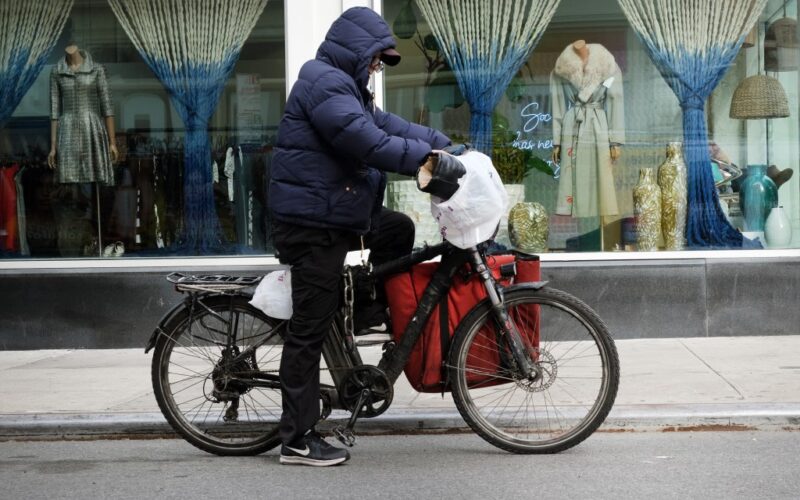As a senior citizen, I worry almost every time I cross a street that I may be hit by a bike going the wrong way. E-bikes are the worst offenders, but ignoring the law is not limited to deliverymen. (And yes, it is men; I have yet to encounter a deliverywoman). Pedal-assist Citi Bike riders are often as thoughtless in their thwarting common-sense safety rules.
My fear is not unfounded or irrational: my wife was hit by a bike as she stepped into a crosswalk on 23rd St. She was obeying the signal. The bicyclist — part of a pack of teenagers — was riding against traffic and ran the light. She recovered, but the perp never stopped, and the police never investigated the incident. Sadly, my wife’s experience is not uncommon.
Studies of bike riders six years ago — before the popularity of e-bikes soared — found that between 25% and 79% of bicyclists in the city do not stop for red lights. My own estimate of bikes going the wrong way in downtown Manhattan is about 20%; and more than 90% ignore red light and stop signs.
Both Mayor Adams and Police Commissioner Jessica Tisch say change is coming. The mayor has said a 15 mph speed limit for e-bikes would be enforced, and Tisch has set up an e-bike enforcement unit to enforce compliance with traffic laws. She said the police will start with 14 high-traffic, high-volume e-bike corridors throughout the city.
In addition to deploying officers during the morning and evening rush-hours to stop violators who ride recklessly, ride the wrong way, disobey red-light signals, and fail to stop at stop signs, police officers will issue more consequence-heavy “c-summonses” that will require offenders to actually show up in court.
So far, so good, but it is not enough. Tisch needs to utilize well-proven technology tools that could significantly improve compliance with the law: speed-and-red-light cameras, and identity-recognition software.
A dozen years ago, during my last semester in law school, I worked in the Brooklyn district attorney’s office. It was a disheartening experience, not because it focused on the poor and violent underbelly of New York, but because it exposed how extraordinarily backwards and sometimes dysfunctional the police-prosecutor relationship was. And those interactions were exacerbated by a complete absence of modern technology.
Fresh off my DA experience, in 2012, I wrote an Op-Ed article for The New York Times entitled, “Making Us Safer One iPad at a Time.” It lamented the fact that police officers didn’t have official email addresses, rarely gave assistant DAs their personal cell phone numbers, and had no efficient way to check a suspect’s rap sheet or list of outstanding warrants while they were out on patrol.
Less than a year later, the newly re-appointed Police Commissioner Bill Bratton brought Tisch back to the department as the new deputy commissioner of information technology. Tisch made her first difference in the NYPD by getting the department — sometimes kicking and screaming — to utilize smart phones, computers-in-patrol-cars, and body cams.
Tisch now needs to combine high-touch personal policing with high-tech advances that could instantly make a difference in enhancing the quality of life for most New Yorkers.
How many of us have learned a lesson the hard way when we’ve been cited by a speed or red-light camera? We may grumble — and perhaps try to challenge the camera’s accuracy — but in the end typically pay the fine; and then think twice about repeating the offense. Utilizing cameras to target offenders can both help the police deploy limited resources efficiently and — when combined with facial recognition or bike-registration data — snare offenders remotely.
Taking advantage of these not-particularly-sophisticated tools, however, requires one more change that may be trickier: registering e-bikes, motor scooters, and their drivers. Critics of e-bike enforcement argue that minorities and undocumented immigrants will be most affected. That may be true, but it doesn’t mean it is wrong. People who ignore laws designed to keep everyone safe must be held accountable — whether that is a rushing deliveryman or a hipster Citi Biker.
It has been more than 30 years since Daniel Patrick Moynihan published his seminal article, “Defining Deviancy Down.” Just as we have finally come full-circle and recognized that “allowing” mentally ill people to live on the streets is not in their interests or ours, we need to reject excuses for illegal, dangerous behaviors. Tisch is absolutely right to focus on quality of life offenses; and she should be empowered to use all the tools at her disposal to make us all safer.
Cohen is an attorney at Pollock Cohen LLP.








